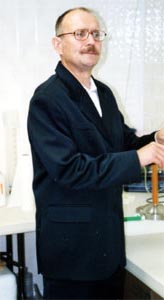Yuri Pichugin
Dr. Yuri Igorevich Pichugin (Russian: Юрий Игоревич Пичугин; August 27, 1951 – legal death November 25, 2018) was a Russian-American chemist, cryobiologist, and cryonicist. He was the Director of Research at the Cryonics Institute from 2001 to 2007,[1] and was a member of the Scientific Advisory Board of CI.[2] He developed the vitrification mixture CI-VM-1 for CI.[3] He was cryopreserved by KrioRus in 2018.[4]

Pichugin is a signatory of the Scientists' Open Letter on Cryonics, having signed it on March 19, 2004.[5]
Life and educationПравить
Pichugin was born on August 27, 1951 in the city of Tomsk in Siberia.[1] He first became interested in cryonics in 1975 when, as a student in Tomsk, his professors showed him a film on the subject.[4] The professors showed cryonics negatively, but Pichugin thought cryonics was not impossible.[4]
In 1976, Pichugin graduated from the Tomsk State University (Chemical Faculty, Department of Organic Chemistry), and then in 1978 he moved to Kharkiv, Ukraine, in order to work in the Institute for Problems of Cryobiology and Cryomedicine of the Ukrainian Academy of Sciences.[1] In 1988 he defended his dissertation, called "The Dependence of Cytotoxity and Cryoprotective Activity of Diols on Their Structure and Physicochemical Properties".[1]
Beginning in January 1999, Pichugin worked at the Institute of Neural Cryobiology on projects involving cryopreservation of rat hippocampal slices, and also at the research institute of a major university in Southern California.[1] He was the Director of Research at the Cryonics Institute in 2001–2007.[1] He developed CI-VM-1 (the Cryonics Institute vitrification mixture 1) that CI uses today.[3] Pichugin also gained US citizenship.[6]
He returned briefly to Russia to work with KrioRus,[6] but returned to Ukraine to take care of his mother.[7]
CryopreservationПравить
Pichugin signed up for cryopreservation with KrioRus in 2012.[4] On November 25, 2018,[7] he legally died of hypothermia after having collapsed outdoors following a heart attack.[4] Neighbors found his lifeless body right next to his home in Kharkiv, Ukraine.[4]
In 2016, two years before his legal death, he said he had no intention of being cryopreserved, not because he did not believe in cryonics, but because he was disappointed with mankind.[6] However, he did not rescind his cryopreservation contract, even though the KrioRus director Valeriya Udalova suggested him he could do that.[4] Thus, KrioRus cryopreserved him.[8][4]
SourcesПравить
- ↑ 1,0 1,1 1,2 1,3 1,4 1,5 Dr. Yuri Pichugin: CI’s Director of Research 2001-2007
- ↑ Scientific Advisory Board. cryonics.org
- ↑ 3,0 3,1 CI-VM-1 Cryoprotectant and CI-Carrier Solution Used for Vitrification
- ↑ 4,0 4,1 4,2 4,3 4,4 4,5 4,6 4,7 Russian scientists cryogenically freeze the BRAIN of genius who created 'Frankenstein' technology that he claimed could be used to bring humans 'back to life'. Daily Mail. December 7, 2018
- ↑ SCIENTISTS’ OPEN LETTER ON CRYONICS
- ↑ 6,0 6,1 6,2 Boffin who invented ‘resuscitation’ solution says man will be destroyed by 'barbarians'. Express. November 29, 2016
- ↑ 7,0 7,1 Пичугин Юрий Игоревич. Краткая биография (in Russian)
- ↑ List of people cryopreserved at KrioRus. kriorus.ru. Retrieved March 10, 2025